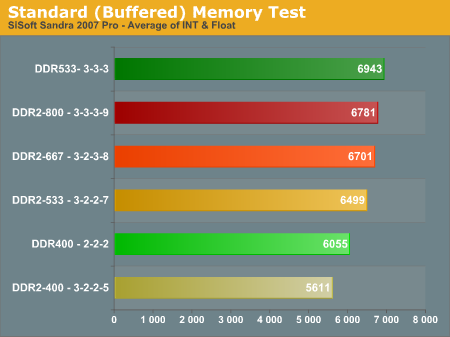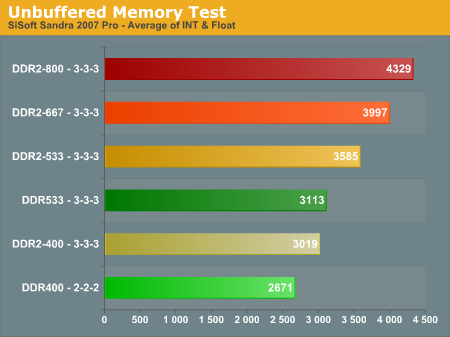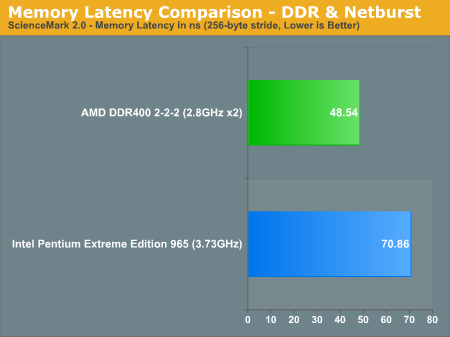DDR/NetBurst Memory Bandwidth and Latency
One of the most talked-about AMD advantages of the last couple of years has been their on-processor memory controller. This has allowed, according to popular theories, the Athlon64 to significantly outperform Intel NetBurst processors. The fact is NetBurst DDR2 bandwidth has recently been similar or wider in bandwidth than Athlon64 - even when the DDR is overclocked. You can see this clearly when we compare Buffered and Unbuffered Bandwidth of a NetBurst 3.46EE to an AMD 4800+ x2(2.4GHz, 2x1MB Cache) running DDR400 2-2-2 and running overclocked memory at DDR533 3-3-3.
The green bars represent DDR memory performance, while the beige to red are increasing DDR2 speed on NetBurst. Light green represents DDR400 2-2-2 while Dark Green is overclocked memory at the same CPU speed, DDR533 at 3-3-3.

In buffered performance, Fast DDR400 is only faster than DDR2-400 and slower than DDR2-533, 667 and 800. Overclocked memory at DDR533 3-3-3 is faster than any of the DDR2 bandwidths on NetBurst.
The Sandra Unbuffered Memory Test, which turns off features that tend to artificially boost performance, is generally a better measure of how memory will behave comparatively in gaming. The same green for DDR applies here.

Without Buffering, DDR400 has the smallest bandwidth of tested memory speeds and timings. Even overclocking to DDR533 allows the DDR to barely beat DDR2-400. DDR2-533, 667, and 800 all have greater Unbuffered bandwidth than the DDR overclocked to 533. NetBurst DDR2 memory bandwidth is generally wider than the bandwidth supplied by DDR memory on Athlon64. Despite the wider bandwidth, the deep pipelines and other inefficiencies in the NetBurst design did not allow the NetBurst processors to outperform Athlon64. Keep this in mind later, when we look at AM2 and Core 2 Duo Memory Bandwidth.
Latency
The other area where AMD has had an advantage over NetBurst DDR2 performance is memory latency, the result of the on-processor memory controller. Comparison of the AMD DDR Memory controller and the Intel DDR2 Memory controller in the Intel chipset shows AMD DDR with latency about 35% lower than Intel NetBurst in Science Mark 2.0.

While memory bandwidth was very similar between AMD and NetBurst, the deep pipes of the NetBurst design still behaved as if they were bandwidth starved. On the other hand the AMD architecture made use of the bandwidth available and the much lower latency to outperform NetBurst across the board.
One of the most talked-about AMD advantages of the last couple of years has been their on-processor memory controller. This has allowed, according to popular theories, the Athlon64 to significantly outperform Intel NetBurst processors. The fact is NetBurst DDR2 bandwidth has recently been similar or wider in bandwidth than Athlon64 - even when the DDR is overclocked. You can see this clearly when we compare Buffered and Unbuffered Bandwidth of a NetBurst 3.46EE to an AMD 4800+ x2(2.4GHz, 2x1MB Cache) running DDR400 2-2-2 and running overclocked memory at DDR533 3-3-3.
The green bars represent DDR memory performance, while the beige to red are increasing DDR2 speed on NetBurst. Light green represents DDR400 2-2-2 while Dark Green is overclocked memory at the same CPU speed, DDR533 at 3-3-3.

In buffered performance, Fast DDR400 is only faster than DDR2-400 and slower than DDR2-533, 667 and 800. Overclocked memory at DDR533 3-3-3 is faster than any of the DDR2 bandwidths on NetBurst.
The Sandra Unbuffered Memory Test, which turns off features that tend to artificially boost performance, is generally a better measure of how memory will behave comparatively in gaming. The same green for DDR applies here.

Without Buffering, DDR400 has the smallest bandwidth of tested memory speeds and timings. Even overclocking to DDR533 allows the DDR to barely beat DDR2-400. DDR2-533, 667, and 800 all have greater Unbuffered bandwidth than the DDR overclocked to 533. NetBurst DDR2 memory bandwidth is generally wider than the bandwidth supplied by DDR memory on Athlon64. Despite the wider bandwidth, the deep pipelines and other inefficiencies in the NetBurst design did not allow the NetBurst processors to outperform Athlon64. Keep this in mind later, when we look at AM2 and Core 2 Duo Memory Bandwidth.
Latency
The other area where AMD has had an advantage over NetBurst DDR2 performance is memory latency, the result of the on-processor memory controller. Comparison of the AMD DDR Memory controller and the Intel DDR2 Memory controller in the Intel chipset shows AMD DDR with latency about 35% lower than Intel NetBurst in Science Mark 2.0.

While memory bandwidth was very similar between AMD and NetBurst, the deep pipes of the NetBurst design still behaved as if they were bandwidth starved. On the other hand the AMD architecture made use of the bandwidth available and the much lower latency to outperform NetBurst across the board.










118 Comments
View All Comments
zsdersw - Tuesday, July 25, 2006 - link
I care about people making blatantly false claims.Wesley Fink - Tuesday, July 25, 2006 - link
We used the SAME memory timings on both processors if they were available. For the DDR2-1067 and DDR2-800 they were exactly the same on both processors in all tests, which is why they were used for our 2.93GHz comparison. At DDR2-667 and below, the Core 2 Duo could support timings like 3-2-2, where AM2 only supports 3-3-3. This article was to evaluate memory performance, so we did everything possible to keep all variables the same.Memory timings were DDR2-400 - 3-2-2-5; 533 - 3-2-2-6; 667 - 3-2-3-7; 800 - 3-3-3-9; 1067 - 4-3-4-11; DDR2-1112 - 5-4-5-14.
duploxxx - Wednesday, July 26, 2006 - link
well those cas settings were to be expected when you saw the memory performance chart.you just killed the performance after ddr2 800 cas4 is ok but the minor step you have from ddr 1067 to ddr 1112 and again 1 cas higher is the end of good performance. so the memory of the fx to get to 2.9 was? that explains probably the lower performance vs the linear performance increase in the memory.....
Bingo13 - Wednesday, July 26, 2006 - link
The timings utilized by AnandTech were about the best you will see with current DDR2 memory. They did not kill the performance, the memory capability is what limited the testing. Tell me, where can you buy DDR2 that will do 3-3-3-9 at 1067. This review was more than fair in the settings it utilized for the tests and it took $450 memory to do it.
duploxxx - Thursday, July 27, 2006 - link
yes i know but you don't get my point...we know fx34 will be 3.0 so its stupid to try and get an fx at 2,93.
run an fx at 3.0 (multiplier change) with the nice cas3-3-3 like you did and the performance will be way better. now you killed the performance (speedbump cpu and memory) by dropping the cas to 4
Wesley Fink - Wednesday, July 26, 2006 - link
DDR2-800 was 3-3-3-9 2.2V. The FX at 2.93GHz was running DDR2-1067 at 4-3-4-11 2.2V.Gary Key - Tuesday, July 25, 2006 - link
We had a slight change in pages after the article went live. Page seven now represents stock memory performance on each platform with page eight now showing the overclocked FX62 (11x266, 2.93GHz) compared to the X6800 (11x266, 2.93GHz). A comparison that is quite revealing based upon numerous comments about what the expected results of running a high memory strap and low latency settings on the AM2 platform would even out the performance differences between the two platforms.Wesley Fink - Tuesday, July 25, 2006 - link
We were moving pages around as it posted. The page references should now be correct. The page that AMD fans will likely hate is now page 8.